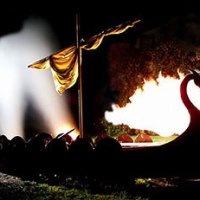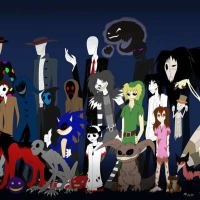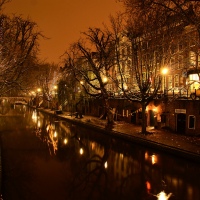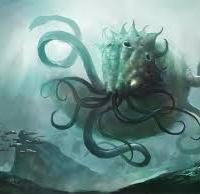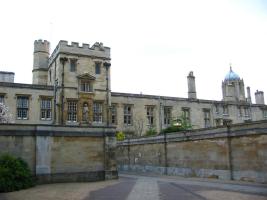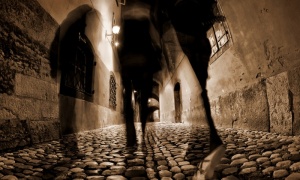Locke & Key is an American comic book series written by Joe Hill, son of Stephen King and a noted horror author in his own right, and illustrated by Gabriel Rodríguez. Quite simply, the series stands as one of the greatest works of modern horror in any medium. It begins with the brutal murder of the Locke family’s father and then moves the survivors of the attack back to their ancestral home, Keyhouse, in Lovecraft, Massachusetts. It may sound a bit hokey and contrived, but the reality is far different. After that shaky little pitch, the comic book series becomes a spellbinding reading experience, demanding page turns as the family comes to terms with its haunted past. The Keyhouse has magical keys that allow their users powers. These keys start revealing themselves to the Locke kids, who use the keys not only for their special powers, but in various attempts to deal with their trauma and to aid them in the struggles of adolescence and fitting in, as a malevolent force bent on unleashing demons long buried hounds them. That concept allows for some incredibly gripping moments throughout the series, which make reading the series’ finale a bittersweet experience.
The Strange Life of John Ruskin
2 Jun
John Ruskin – art critic, philanthropist and prominent social thinker – was also, by all accounts, a very odd man. Probably the most infamous aspect of his personal life was the strange annulment of his marriage to Effie Gray and the subsequent rumours that this gave rise to concerning his sexuality. He has variously been described as a prude, asexual, homosexual and even, like his contemporary and fellow Oxford man Lewis Carroll, showing an unhealthy interest in children. None of these allegations, it must be stressed, has ever been made out, which is hardly surprising given that Ruskin was an intensely private man. For this reason it is also very difficult to determine whether there is any truth in the suggestions that Ruskin received messages from a supposed former lover, Rose La Touche, even after her death and that he once encountered the Devil himself at Brantwood. With the forthcoming release of the feature film Effie, based on Ruskin’s bizarre ‘marriage’, now seems as good a time as any to examine the strange life of John Ruskin.
The Picture of Oscar Wilde
7 Apr
“All art is useless” – so says the author’s 1891 preface to The Picture of Dorian Gray (sometimes referred to, wrongly, as The Portrait of Dorian Gray), the only published novel by Oscar Wilde. This darkly sardonic, Faustian-themed novel very much reflects the interests and personality of its author. Ever the aesthete, Wilde was himself profoundly affected by beauty and lived and dressed in a manner which, compared to the Victorian styles and mores of the time, was regarded as flamboyant. As such, he was often publicly caricatured and the target of much moral outrage in Europe and America. His writings (including Dorian Gray, with its homoerotic themes) also brought much controversy for him. He was nonetheless part of the ever-growing movement of ‘decadents’ who advocated pacifism, social reform and libertarianism. While many vilified him, he was making his mark with style and wit and enjoyed much success with many of his plays. Wilde was also lauded by and acquainted with many influential figures of the day, including fellow playwright George Bernard Shaw, American poets Walt Whitman and Henry Wadsworth Longfellow and English author and social critic John Ruskin. In Dorian Gray the titular hero, realising that his beauty will one day fade, expresses a desire to sell his soul to ensure that his portrait ages while he does not. Dorian’s wish is fulfilled, plunging him into debauched acts. The portrait serves both as a reminder of the effect each act has upon his soul, with each sin displayed as a disfigurement or ageing of his form, and as a warning to all that no amount of outer beauty can make up for the darkness within.
Where is the Mona Lisa?
11 Nov
The answer to the above question may seem self-evident: in the Louvre. But the matter is not quite as straightforward as it looks. The Mona Lisa is better known in continental Europe as La Gioconda, or ‘the smiling woman’ – the word means the same as the antiquated English term ‘jocund’. It was painted, as everyone knows, by the great Italian artist Leonardo da Vinci. Mona Lisa was a young married woman who was about 24 when Leonardo met her. She was the wife of a man 20 years her senior, and when Leonardo started to paint her around 1500 she had just lost her child (her husband had to hire jesters and musicians to make her smile during the early sittings). For some reason Leonardo became obsessed with her, and went on painting her for several years, always dissatisfied with his work. He gave the unfinished portrait to Mona Lisa’s husband when he left Florence in 1505. This, we assume, is the famous portrait in the Louvre. Yet this raises a puzzling question. If it was given, unfinished, to Mona Lisa’s husband in 1505, how did it end up in the possession of King Francis I at Fontainbleu, in a finished state, a mere forty or so years later? Also, why, in 1584, did the art historian Lomazzo publish a book on painting in which he refers to ‘the Gioconda AND the Mona Lisa’, as if they were two separate paintings?


